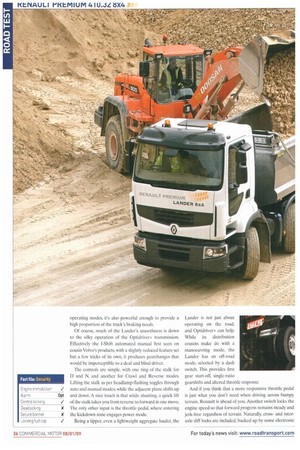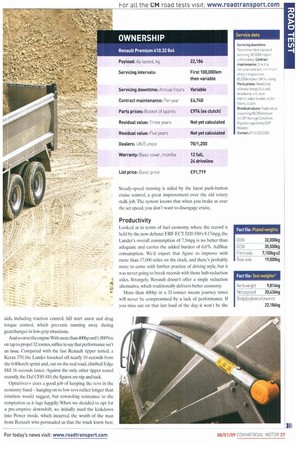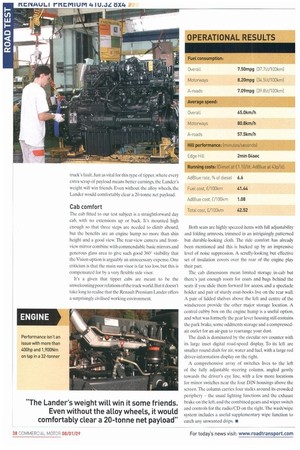For Long enough, Renault's sole offering to the tipper market
Page 34

Page 35

Page 36

Page 37

Page 38

If you've noticed an error in this article please click here to report it so we can fix it.
was the Kerax. Undeniably bulletproof enough for the toughest muckaway operations, it could do with losing a bit of weight for more highway-based work. A fully-specced Kerax with a steel body could weigh in some two tonnes over the rivals' lightweight alloy-bodied products, a figure that would not help your earnings potential when tipping asphalt into a Barber Green.
So enter the Premium Lander, Renault's lightweight alternative. The full name is used to emphasise the fact that while the Kerax is effectively an off-road machine with highway capabilities, the Lander is an on-road vehicle closely related to the Premium distribution range, with added off-road ability. Not that it's a half-hearted compromise — as you will read, it has features that confirm it as a true construction asset.
The Lander range comes in 4x2, 6x2, 6x4 and 8x4 rigid versions. together with 4x2 and 6x4 tractors, Some 31 different wheelbase/ axle configurations are available just on the rigids. Five nominal power ratings span 280 to 450hp. driving gearboxes that range from six to 16-speed manuals and the 12-speed automated Optidriver+ tested here.
Unusually for a lightweight tipper, the Lander axle availability list includes a 2:1 hub-reduction unit, the fitment on our test truck. The other highlight of its spec is the second-from-top 10.8-litre 410 engine rating, with the £1,842 Euro-5 option — like all heavy Renaults, courtesy of SCR. The Optidriver+ transmission fitted is effectively the standard issue, but attracts a £4,204 premium that also brings a transmission oil cooler, Optibrake (combined exhaust brake and engine compression brake), armrests and a weight saving of 24kg.
Saving rather more weight on the test truck, 180kg to be exact, are a set of polished Alcoa alloy wheels for another £4,982. Other major options are the £128 nearside Vision door (glazed lower panel and horizontally sliding window) and the £569 vertical exhaust, which just happen to total £7 more than the rebate for speccing the day cab.
The essential aggregate body is a 15.8m Thompsons Sandmaster with single-skin aluminium construction. Edbro CX15 front-end gear does the tipping through a pneumatic Auto-Loc tailgate, with a Sheet Pro front-torear boom system keeping the contents aboard.
One interesting feature of the body is the everlasting shovel guaranteed never to wear out, mainly on account of having to remove the sheeting system to take it off its brackets!
On the road
Select D with the merest flick of the wrist on the conveniently located main right-hand column stalk and you're almost ready to go. All that's left to do is to turn your left shoulder inside out to reach the poorly located park brake lever and wrestle with its notchy release mechanism. You can then move off and enjoy a smooth and refined experience. There was a time in the 1960s and 1970s when Renault was a byword for car comfort, and we can only assume that Renault Trucks has discovered the secret recipe in some long-lost filing cabinet.
If you can imagine a graph of the unwanted noise, vibration and harshness reaching the driver, it's as though all the sharp peaks have been chopped off, leaving nicely rounded edges:111e well-specified seats help, of course, but there's normally no hiding place for any unwelcome shocks that are transmitted through the floor and steering.
Even on the A422 from Brackley to Buckingham, long considered the worst surface on any of our test routes hut now worse than ever, the ride gives no clue that all that separates the chassis from the road is half a dozen sturdy steel leaf springs.The steering, which felt a bit under-geared and ponderous around the many roundabouts of Milton Keynes, comes into its own on the open road, precise but with a good resistance to being diverted from the chosen line by tramlines and subsiding edges.
The braking figures in our table look unimpressive, but do not reflect the fact they were obtained on a damp track at not much above freezing point. To get those figures. the ABS was definitely having to earn its keep. On the road, the all-disc service brakes went about their business unnoticed, while the two-stage engine brake certainly proved a betterthan-average example of the type. Sophisticated in its operating modes, it's also powerful enough to provide a high proportion of the truck's braking needs.
Of course, much of the L,ander's smoothness is down to the silky operation of the Optidriver+ transmission. Effectively the 1-Shift automated manual first seen on cousin Volvo's products, with a slightly reduced feature set but a few tricks of its own, it produces gearchanges that would be imperceptible to a deaf and blind driver.
The controls are simple. with one ring of the stalk for D and N. and another for Crawl and Reverse modes. Lifting the stalk as per headlamp-flashing toggles through auto and manual modes, while the adjacent plane shifts up and down. A nice touch is that while shunting. a quick lift of the stalk takes you from reverse to forward in one move. The only other input is the throttle pedal. where entering the kickdown zone engages power mode.
Being a tipper, even a lightweight aggregate hauler, the Lander is not just about operating on the road, and Optidriver+ can help. While its distribution cousins make do with a manoeuvring mode, the Lander has an off-road mode, selected by a dash switch. This provides first gear start-off, single-ratio gearshifts and altered throttle response.
And if you think that a more responsive throttle pedal is just what you don't need when driving across bumpy terrain, Renault is ahead of you. Another switch locks the engine speed so that forward progress remains steady and jerk-free regardless of terrain. Naturally, crossand interaxle diff locks are included, backed up by some electronic aids, including traction control, hill start assist and drag torque control, which prevents running away during gearchanges in low-grip situations.
And so on to the engine. With more than 400hp and 1,900Nm on tap to propel 32 tonnes, suffice to say that performance isn't an issue. Compared with the last Renault tipper tested, a Kerax 370, the Lander knocked off nearly 10 seconds from the 0-80km/h sprint and, out on the real road, climbed Edge Hill 16 seconds faster. Against the only other tipper tested recently, the Daf CF85 410, the figures are nip and tuck.
Optidriver+ does a good job of keeping the revs in the economy band — hanging on to low revs rather longer than intuition would suggest, but rewarding resistance to the temptation as it lugs happily. When we decided to opt for a pre-emptive downshift, we initially used the kickdown into Power mode, which incurred the wrath of the man from Renault who persuaded us that the truck knew best Steady-speed running is aided by the latest push-button cruise control, a great improvement over the old rotary stalk job. The system knows that when you brake at over the set speed, you don't want to disengage cruise.
Productivity
Looked at in terms of fuel economy, where the record is held by the now defunct ERF ECT D20 350's 9.17mpg, the Lander's overall consumption of 7.5inpg is no better than adequate and carries the added burden of 6.6% AdBlue consumption. We'd expect that figure to improve with more than 17.000 miles on the clock, and there's probably more to come with further practice of driving style, but it was never going to break records with those hub-reduction axles. Strangely, Renault doesn't offer a single reduction alternative, which traditionally delivers better economy.
More than 400hp in a 32-tonner means journey times will never be compromised by a lack of performance. If you miss out on that last load of the day, it won't be the truck's fault. Just as vital for this type of tipper, where every extra scrap of payload means better earnings, the Lander's weight will win friends Even without the alloy wheels, the Lander would comfortably clear a 20-tonne net payload.
Cab comfort
The cab fitted to our test subject is a straightforward day cab, with no extensions up or back. Its mounted high enough so that three steps are needed to climb aboard, but the benefits are an engine hump no more than shin height and a good view, The rear-view camera and frontview mirror combine with commendable basic mirrors and generous glass area to give such good 360° visibility that the Vision option is arguably an unnecessary expense. One criticism is that the main sun visor is far too low, but this is compensated for by a very flexible side visor.
It's a given that tipper cabs are meant to be the unwelcoming poor relations of the truck world. But it doesn't take long to realise that the Renault Premium Lander offers a surprisingly civilised working environment. Both seats are highly specced items with full adjustability and folding armrests, trimmed in an intriguingly patterned but durable-looking cloth. The ride comfort has already been mentioned and this is backed up by an impressive level of noise suppression. A scruffy-looking but effective set of insulation covers over the rear of the engine play their part.
The cab dimensions mean limited storage in-cab but there's just enough room for coats and bags behind the seats if you slide them forward for access, and a spectacle holder and pair of sturdy coat-hooks live on the rear wall. A pair of lidded shelves above the left and centre of the windscreen provide the other major storage location. A central cubby box on the engine hump is a useful option, and what was formerly the gear lever housing still contains the park brake, some oddments storage and a compressedair outlet for an air-gun to rearrange your dust.
The dash is dominated by the circular rev counter with its large inset digital road-speed display. To its left are smaller round dials for air, water and fuel, with a large red driver-information display on the right.
A comprehensive array of switches lives to the left of the fully adjustable steering column, angled gently towards the driver's eye line, with a few more locations for minor switches near the four DIN housings above the screen. The column carries four stalks around its crowded periphery — the usual lighting functions and the exhaust brake on the left, and the combined gears and wiper switch and controls for the radio/CD on the right. The wash/wipe system includes a useful supplementary wipe function to catch any unwanted drips. •








































































































































